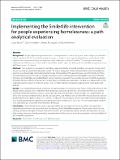Files in this item
Implementing the Smile4life intervention for people experiencing homelessness : a path analytical evaluation
Item metadata
| dc.contributor.author | Beaton, Laura | |
| dc.contributor.author | Humphris, Gerry | |
| dc.contributor.author | Rodriguez, Andrea | |
| dc.contributor.author | Freeman, Ruth | |
| dc.date.accessioned | 2021-08-06T11:30:15Z | |
| dc.date.available | 2021-08-06T11:30:15Z | |
| dc.date.issued | 2021-08-05 | |
| dc.identifier | 275335242 | |
| dc.identifier | 16858db8-5973-42a7-b936-c3866cb9cd6f | |
| dc.identifier | 000684415200001 | |
| dc.identifier | 85112632293 | |
| dc.identifier.citation | Beaton , L , Humphris , G , Rodriguez , A & Freeman , R 2021 , ' Implementing the Smile4life intervention for people experiencing homelessness : a path analytical evaluation ' , BMC Oral Health , vol. 21 , 383 . https://doi.org/10.1186/s12903-021-01747-1 | en |
| dc.identifier.issn | 1472-6831 | |
| dc.identifier.other | RIS: urn:F1A5BB40DD4846A7E544DD0102114262 | |
| dc.identifier.other | RIS: Beaton2021 | |
| dc.identifier.other | ORCID: /0000-0002-4601-8834/work/98196728 | |
| dc.identifier.uri | https://hdl.handle.net/10023/23731 | |
| dc.description | This evaluation was part of the Smile4life programme funded by the Scottish Government (grant number: 121.80.4497). | en |
| dc.description.abstract | Background: People experiencing homelessness have high levels of dental decay, oral cancer and poor oral health-related quality of life. The Scottish Government sought to address these issues by developing a national oral health improvement programme for people experiencing homelessness, named Smile4life. The aim was to investigate implementation behaviours and the role of work-related beliefs upon the delivery of the Smile4life programme across NHS Board areas in Scotland. Methods: Non-probability convenience sampling, supplemented by snowball sampling, was used to recruit practitioners working across the homelessness sector. The overall evaluation of the implementation of the Smile4life programme was theoretically informed by the Behaviour Change Wheel. The questionnaire was informed by the Theoretical Domains Framework and was divided into three sections, demography and Smile4life Awareness; Smile4life Activities; and Smile4life work-related beliefs. A psychometric assessment was used to develop Smile4life Awareness, Smile4life Activities, Ability to Deliver and Positive Beliefs and Outcomes subscales. The data were subjected to K-R20, exploratory factor analysis, Cronbach’s alpha, t-tests, ANOVA, Pearson’s correlation analysis and a multivariate path analysis. Results: One hundred participants completed the questionnaire. The majority were female (79%) and worked in NHS Boards across Scotland (55%). Implementation behaviour, constructed from the Delivering Smile4life scale and the summated Smile4life activities variable, was predicted using a linear model a latent variable. The independent variables were two raw variables Positive Beliefs and Outcomes, and Ability to deliver Smile4life. Results showed relatively good model fit (chi-square (1.96; p > 0.15), SRMR (< 0.08) and R2 (0.62) values). Positive and highly significant loadings were found describing the Implementation Behaviour latent variable (0.87 and 0.56). The two independent variables were associated (p < 0.05) with Implementation Behaviour. Conclusions: Work-related factors, such as positive beliefs and outcomes and ability to deliver are required for implementation behaviours associated with the delivery of the Smile4life programme. Future work should include training centred on the specific needs of those involved in the homelessness sector and the development of accessible training resources, thereby promoting implementation behaviours to assist the progression and sustainability of the Smile4life programme. | |
| dc.format.extent | 8 | |
| dc.format.extent | 1021993 | |
| dc.language.iso | eng | |
| dc.relation.ispartof | BMC Oral Health | en |
| dc.subject | Oral health | en |
| dc.subject | Homeless persons | en |
| dc.subject | Questionnaires | en |
| dc.subject | HV Social pathology. Social and public welfare | en |
| dc.subject | RK Dentistry | en |
| dc.subject | E-DAS | en |
| dc.subject | SDG 3 - Good Health and Well-being | en |
| dc.subject.lcc | HV | en |
| dc.subject.lcc | RK | en |
| dc.title | Implementing the Smile4life intervention for people experiencing homelessness : a path analytical evaluation | en |
| dc.type | Journal article | en |
| dc.contributor.institution | University of St Andrews. Sir James Mackenzie Institute for Early Diagnosis | en |
| dc.contributor.institution | University of St Andrews. Population and Behavioural Science Division | en |
| dc.contributor.institution | University of St Andrews. WHO Collaborating Centre for International Child & Adolescent Health Policy | en |
| dc.contributor.institution | University of St Andrews. Health Psychology | en |
| dc.contributor.institution | University of St Andrews. School of Medicine | en |
| dc.identifier.doi | 10.1186/s12903-021-01747-1 | |
| dc.description.status | Peer reviewed | en |
This item appears in the following Collection(s)
Items in the St Andrews Research Repository are protected by copyright, with all rights reserved, unless otherwise indicated.

